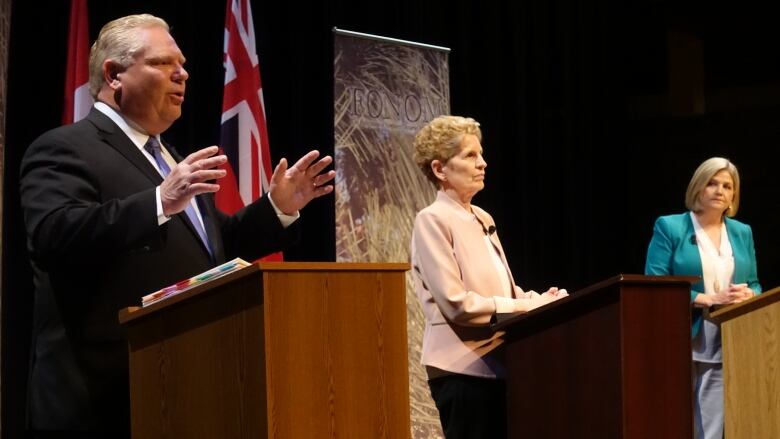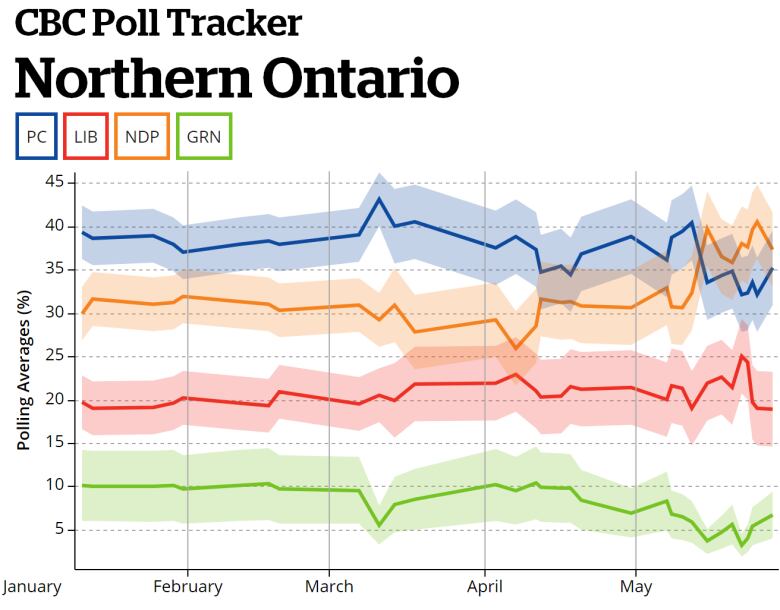NDP, PCs looking to northern Ontario for seat gains
The New Democrats have won the region in two consecutive elections. Will they make it three?

For two elections in a row, the provincial New Democrats have won the most seats and the most support in northern Ontario. They could do so again in next week's provincial vote and the region could even play a small but important role in the formation of an NDP government.
That's assuming, of course, thatthe NDP can stopDoug Ford from pulling some of those seats into the Progressive Conservative column.
In the 2014 provincial election, the New Democrats won six of northern Ontario's 11 seats and 39 per cent of the vote in the region an improvement over the party's 38 per cent in 2011 and 34 per cent in 2007.The Liberals placed not too far behind at 34 per cent, while the PCs took just 21 per cent in the region and the Greens tookfive per cent.
Following that vote, two byelections saw the Liberals win Sudbury away from the New Democrats and Sault Ste. Marie swing to the PCs from the Liberals.
The map has changed also, with two new ridings being added to the far north of the region. In 2014, the New Democrats won the most votes in the territory occupied by thesenewly created seats.
But the June 7 election could see some changes.
As of the May 28 update of the CBC Poll Trackeran aggregation of all publicly available polling datathe NDPis narrowly ahead in the region with 37 per cent of the vote, followed by the PCs at 35 per cent. The Liberals followwell back with just 19 per cent and the Greens with seven per cent.
(The Poll Tracker is updated with new data whenever they're madeavailable see the latest numbers here.)
About two per cent ofnorthernOntarianssay they will vote for a party other than the four main ones. Both the Libertarians and the Northern Ontario Party are running candidates in most ridings in the north.
The sample sizesin northern Ontario arequite small, making it difficult to pinpoint exactly where voting intentions sit in the region. But the polls have been broadly consistent. Surveys conducted in the last week have put the NDPbetween 35 and 45 per cent support in the region, with the PCs between 29 and 39 per cent and the Liberals between 14 and 27 per cent.
That suggests the NDP is likely to finish first in the region and the Liberals third, while the PCs have a small chance of pulling in more support than the New Democrats.
NDP prospecting for gains in the north
In the aggregate, the NDP's vote in northern Ontariohas remained relatively stable since 2014 putting the region out of step with the rest of the province, where the party has made significant gains recently. Thenumbersalso pointto a roughly 29-point swing between the PCs and the Liberals in the region, with the PCs picking up 14percentage points and the Liberals dropping 15.
That swing puts in play the northern ridings the Liberals hold now. Starting from such a low base of support, the PCs' potential for gains is relatively limited except perhaps in KenoraRainy River, where former Conservative MP Greg Rickford has a chance to pull the seat away from the New Democrats (Sarah Campbell, the incumbent NDP MPP in the riding, is not running for re-election).
But while the New Democrats could losethat seat, the drop in Liberal support could put ridings like Sudbury (where former NDP MP Glenn Thibeault took the seat for the Liberals in a controversial byelection),Thunder BayAtikokan and Thunder BaySuperior North in the NDP'sgrasp.
All three seats were occupied by Liberal cabinet ministers at dissolution: Thibeault, Bill Mauro in Thunder BayAtikokan and Michael Gravelle in Thunder BaySuperior North.
The region could see some surprises, though. The Poll Tracker's seat projection model suggests that Thunder BayAtikokan could turn out to be athree-way race, with the Liberals and New Democrats in a close fight in Sudbury and Thunder BaySuperior North and the PCs and NDPbattling it out in KenoraRainy River and Timmins.
All of which means the New Democrats could win between six and 10 seats in northern Ontario, the PCs between three and six and the Liberals between zero and three.
Valuable seats
For the NDP, winning those three extra seats could turn out to be very important, as the party is unlikely to have a high vote efficiency in southern Ontario; the PCs could win many more southern seats than the NDP with only slightly more of the popular vote.
Conversely, preventing the NDPfrom picking up a few extra seats in a traditionally strong region for the party would be good news for Ford's PCs.
And the Liberals need to hold every seat they can to avoid a catastrophic result: Sudbury and the two Thunder Bay seats are going to be high on that must-save list.
The 13 ridings in northern Ontario might not prove to be decisive to the outcome of the June 7 vote. But in what could prove to be a close election and a potentially disastrous one for the Liberals every seat will count.













_(720p).jpg)


 OFFICIAL HD MUSIC VIDEO.jpg)
.jpg)



























































































